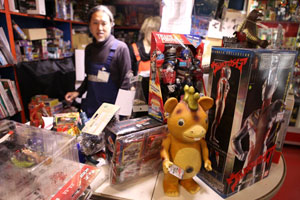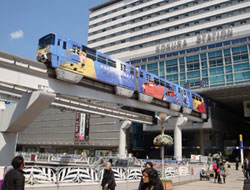Web Japan > Trends in Japan > Pop Culture > Japan's New Subculture Hubs
Japan's New Subculture Hubs
Akiba Isn't Japan's Only Slice of Otaku Heaven!
Today, Akihabara (affectionately known as Akiba) is just about synonymous with Japanese subculture. In fact, it is hallowed ground for many fans of anime, manga comics and character figures. Historically famous as a shopping district for electronics, Akiba in recent years has undergone a transformation, becoming a gathering place and hub for the young and fans of a variety of thriving subcultures. However, Akiba is not the only such subculture mecca. Indeed, there are a number of such spots elsewhere in Japan. Here we take a look at a few.

Nakano Broadway: one of many hallowed playgrounds for subculture fans and a mecca for all things loved by otaku, such as manga, toys and games. It is home to shops such as the iconic Mandarake secondhand manga shop, the main branch of which is shown here.

Displays of toy heroes from the past stop many shoppers in their tracks. This is a photograph of specialty toyshop Mandarake.
Enlarge photoExploring Otaku CultureOne magnet for fans of many genres of Japanese subculture is conveniently located no more than a five-minute train ride from Shinjuku, one of Tokyo’s busiest areas. We are talking about Nakano. Get off at JR Nakano Station and a short walk will bring you to the iconic Nakano Broadway shopping mall. Floor two through floor four of this classic shopping mall host around 80 shops selling subculture-related goods. Emerge from the elevator on any floor and you may as well have happened upon a different world. Manga comics and celluloid pictures (constituent drawings of an animation movie) are a given, and you can also expect to find shops specializing in everything from character figures and movie posters to old records and train-related items. Another exciting encounter is the otherworldly, with alien-esque objects displayed on the walls of some shops and the unimaginable — including a store with a cave-like entrance. A visit here might be better characterized as an adventure rather than mere shopping.

Small shops packed with anime-related goods cater to fans including many ardent collectors from overseas that frequent these shops. (Photo courtesy of Gaocchi)
Enlarge photoIn Japan, fans of anime, manga, figures and the like are often collectively referred to as otaku, or obsessive hobbyists. While often grouped together, these enthusiasts enjoy their passions in a variety of ways. For instance, when it comes to figures, some young fans dig new figurine creations while others are collectors that seek out only vintage items. And with its many shops dealing in older, classic items, Nakano Broadway is hallowed ground for many such collectors.
Peek inside one such store and you will find its narrow confines, not much more than 20 m2, packed with plastic dolls and figures ranging from heroes to monsters all produced from the 1960s to the 1980s. The selection includes everything from Godzilla figures to limited-edition heroes and characters from manga — treasures that hardcore collectors would die for. Rumors of hidden gems travel fast and collectors from overseas also frequent these shops, with one shop manager saying, “Foreign collectors are amazing. They really know their stuff, many ways better than Japanese collectors.”

Osu Shopping Arcade, the stage of the World Cosplay Summit parade. (Photo courtesy of World Cosplay Summit Executive Committee)
Enlarge photoRural Cosplay Capital in Old TownWhile people tend to focus on Tokyo when it comes to Japanese subculture, there are indeed robust hubs of subculture beyond the metropolis.
One subculture mecca that will not be ignored is Osu Shopping Arcade. Located in Nagoya, central Japan, and one of Japan’s three major cities, this shopping district derives its name from the Osu Kannon Temple, which was relocated here nearly 400 years ago and formed the heart of the town. Despite its ties with history, this district is anything but mired in tradition. Surprisingly, it is also hallowed ground when it comes to fans of cosplay. Short for costume play, cosplay involves so-called “cosplayers” dressing up and sometimes engaging in role playing, often as their favorite manga, anime or game characters.
Osu is also known among enthusiasts as the birthplace of the annual World Cosplay Summit (WCS), which started in 2003. Each year it attracts cosplayers from around the world. Participants perform, vying for the coveted title of WCS grand champion — all of which makes this one of Japan’s major cosplay hubs and a platform for sharing cosplay information and culture with the world.

Cosplay fans and spectators on hand for the World Cosplay Summit crowd the grounds of the Osu Kannon Temple, the starting point of the summit parade. (Photo courtesy of World Cosplay Summit Executive Committee)
Enlarge photoNearly 500 summit participants join cosplayer representatives from around the world to take part in the annual event’s hallmark cosplayer parade, forming a procession through Osu Shopping Arcade. In fact, the event has attained such a level of popularity that the mayor of Nagoya and the governor of Aichi Prefecture have even been known to wear costumes to promote the event for the thousands who turn out each year.
With its long history and smattering of shops selling traditional Japanese sweets as well as sundry goods juxtaposed with modern business catering to the fans of subcultures, ranging from cosplay and figures to maid cafes and rock music, this shopping street is truly unique.

Characters from Japanese anime are on hand to greet visitors to the opening of “Aruaru City,” a collection of specialty shops in Kitakyushu City catering to subculture enthusiasts.
Enlarge photoNew Subculture Hub in Kyushu Region
Subcultures hinging on Japanese anime and manga only continue to develop as new hubs and pockets of subculture appear and thrive throughout Japan. One such spot is “Aruaru City”, located in front of JR Kokura Station in Kitakyushu city, Fukuoka Prefecture. Having opened its doors only in the spring of 2012, it has already made quite a splash.
Aiming to “become a bastion of Japanese subculture and provide related information to the world,” this seven-floor complex hosts nearly 20 shops that offer goods ranging from manga and anime to games and cosplay. Establishments such as the only café in Japan dedicated to playing anime music and a zone where cosplay outfits are provided at no cost for taking pictures for stickers have proved popular otaku fans to turn out in force, especially on weekends.

A monorail train decorated in an illustration depicting the anime Galaxy Express 999 departs from JR Kokura Station. (Photo courtesy of Kitakyushu City)
Enlarge photoKitakyushu is home to many manga artists, including Leiji Matsumoto who has penned many science fiction comics, such as Space Battleship Yamato, Captain Harlock and Galaxy Express 999, and boasts an incredibly large fan base not only in Japan but overseas as well. Against this background, Kitakyushu has been especially eager to embrace the subculture community, even decking out a local monorail train in a massive illustration from Galaxy Express 999, as well as supporting the construction of a massive manga museum in “Aruaru City.”
Today, characters from Japanese anime, manga and games have found a place in the hearts of many fans worldwide who often find them kawaii, or cute and cool. Japanese universities are even establishing departments dedicated to the study of these subcultures and which are popular with both Japanese and foreign students. Among this dynamism and change, one thing remains certain: Japan’s subcultures will continue to please and surprise their growing fan bases both at home and abroad. (July 2012)
- A manga Lover's Paradise (July 2012)
